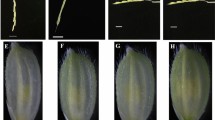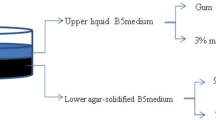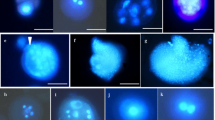Abstract
Shed microspore embryogenesis and fertile plantlet regeneration were observed in a salt susceptible × salt tolerant indica rice F1 hybrid involving IR 24 and CRM 30. The in vitro culture response and regeneration of green plantlets in the hybrid were superior to those of the parents. Direct embryogenesis and plantlet regeneration with multiple tillers were observed in shed microspore embryos. In intact anther culture, plantlet development from microspore involved a callus phase. The number of multiple tillers developed through secondary embryogenesis was almost equal in both the cases. However, the results indicate that regeneration of green plantlets was higher in case of shed microspore culture in liquid medium containing the synthetic polymer Ficoll 400 than from intact anthers cultured on a semi-solid system. Shed microspore culture produced a number of double haploids, which may result in far reaching consequences in genetic improvement of rice.
Similar content being viewed by others
References
Armstrong TA, Metz SG & Mascia PN (1987) Two regeneration systems for the production of haploid plants from wheat anther culture. Plant Sci. 51: 231-237
Chen Y (1983) Anther and pollen culture of rice in China. In: Cell and Tissue Culture Technique for Cereal Improvement (pp 11-26). Science Press, Beijing, China and IRRI, Philippines
Chen Y (1986) Haploids of Higher Plants in Vitro (pp 118-137). Springer-Verlag, Heidelberg, Berlin
Chen Y, Wang R, Tian W, Zuo Q, Zheng S, Lu D & Zhang G (1980), Studies on pollen culture in vitro and induction of plantlets in Oryza sativa sub sp. Keng. Acta Genet. Sin. 7: 46-53
Cho MS & Zapata FJ (1988) Callus formation and plant regeneration in isolated pollen culture in rice (Oryza sativa L. cv. Taipei 309). Plant Sci. 58: 239-244
Cho MS & Zapata FJ (1990) Plant regeneration from isolated microspore of indica rice. Plant Cell Physiol. 31: 881-885
Cistue L, Ziauddin, Simion E & Kasha KJ (1995) Effects of culture conditions on isolated microspore response of barley cultivar Igri. Plant Cell Tiss. Org. Cult. 42: 163-169
Datta SK (1995) Hand-out supplied to trainees, ARBN II, 15 Oct-14 Dec., 1995, IRRI, Manila, Philippines
Datta SK & Wenzel G (1987) Isolated microspore derived plant formation via embryogenesis in Triticum aestivum L. Plant Sci. 48: 49-54
Datta SK, Datta K & Potrykus I (1990) Embryogenesis and plant regeneration from microspores of both 'indica' and 'japonica' rice (Oryza sativa). Plant Sci. 67: 83-88
Foroughi-Wehr B & Friedt W (1984) Rapid production of recombinant barley yellow mosaic virus-resistance Hordeum vulgare lines by anther culture. Theor. Appl. Genet 67: 377-382
Gaillard A, Vergne P & Beckerts M (1991) Optimization of maize microspore isolation and culture conditions for reliable plant regeneration. Plant Cell Rep. 10: 55-58
Gamborg OL, Miller RA & Ojima K (1968) Nutrient requirements of suspension cultures of soybean root cells. Exp. Cell. Res. 50: 151-158
Gupta HS & Borthakur DN (1987) Improvement rate of callus induction from rice anther culture following microscopic staging of microspores in iron alum-haematoxylin. Theor. Appl. Genet. 74: 95-99
Henry Y & de Buyser J (1981) Float culture of wheat anthers. Theor. Appl. Genet. 60: 77-79
Hu H & Huang B (1987) Application of pollen-derived plants to crop improvement. Int. Rev. Cyt. 107: 293-311
Hu H (1985) Biotechnology in International Agricultural Research (pp 75-84). International Rice Research Institute, Manila, Philippines
Jähne A & Lörz H (1995) Cereal microspore culture. Plant Sci. 109: 1-12
Jia YJ, Abe T & Futsuhara Y (1987). Plant regeneration by pollen culture in rice. Rice Genet. Newsl. 4: 109-110
Kao AN (1981) Plant formation from barley anther cultures with ficoll media. Z. Pflanzenphysiol. 103: 437-443
Kasha KJ, Ziauddin A & Cho UH (1990) Haploids in cereal improvement: anther and microspore culture. In: J.P. Gustafson (ed) Gene Manipulation in Plant Improvement II (pp 213-235). Plenum Press, New York
Lichter R (1982) Induction of haploid plants from isolated pollen of Brassica napus. Z. Pflanzenphysiol. 105: 427-434
Mandal Asit B., Sheeja TE & Roy Bidhan (2000) Assessment of androclonal variation in an indica rice PTB 28. Ind. J. Exp. Biol. 38: 1054-1057
Matsoshima T, Kikuchi S, Takaiwa F & Oono K (1988) Regeneration of plants by pollen culture in rice (Oryza sativa L.). Plant Tiss. Cult. Lett. 5(2): 78-81
Ogawa T, Fukuoka H & Okhawa Y (1995). Plant regeneration through direct culture of isolated pollen grains in rice. Breeding Science 45(3): 301-307
Ouyang TW, Hu H, Chuang CC & Tsen CC (1973) Induction of pollen plants from anther of Triticum astivum L. cultured in vitro. Scientia Sinica 16: 79-95
Ouyang JW, Zhou SM & Jia SE (1983) The response of anther culture to culture temperature in Triticum astivum L. Theor. Appl. Genet. 66: 101-109
Pulver EL & Jennings PR (1985) Application of anther culture to high volume rice breeding. In: Int. Rice Genetic Symp. (pp 811-820). International Rice Research Institute, Manila, Philippines
Raina Satish K (1997) Doubled haploid breeding in cereals In: Plant Breeding Reviews, Vol 15 (pp 141-186). JohnWiley & Sons Inc.
Raina SK (1989) Tissue culture in rice improvement status and potential. Adv. Agron 42: 339-379
Raina SK & Irfan ST (1998) High-frequency embryogenesis and plantlet regeneration from isolated microspores of indica rice. Plant Cell Rep. 17: 957-962
Raina SK & Zapata FJ (1997) Enhanced anther culture efficiency of indica rice (Oryza sativa L) through modification of the culture media. Plant Breed. 116: 305-315
Srivastave P & Johri B (1988) Pollen embryogenesis. J. Palynol. 23: 83-99
Sunderland N & Roberts M (1977) New approach to pollen culture. Nature 270: 236-238
Swanson B, Coumans MP, Wu SC, Barsby TL & Beversdirf WD (1987) Efficient isolation of microspores and the production of microspore-derived embryos from Brassica napus. Plant Cell Rep. 6: 94-97
Tuvesson IKD & Ohlund RCV (1993) Plant regeneration through culture of isolated microspores of Triticum aestivum L. Plant Cell Tiss. Org. Cult. 34: 163-167
Wei ZM, Kyo M & Harada H (1986) Callus formation and plantlet regeneration through direct culture of isolated pollen of Hordeum vulgare cv 'sabarlis'. Theor. Appl. Genet. 72: 252-255
Xie J, Gao M, Cai Q, Cheng X, Shen Y & Liang Z (1995) Improved isolated microspore culture efficiency in medium with maltose and optimized growth regulator combination in japonica rice (Oryza sativa L.). Plant Cell Tiss. Org. Cult 42: 245-250
Yoshida Shouichi, Forno D, Cock JH & Gornez K (1976) Laboratory Manual for Physiological Studies of Rice. The International Rice Research Institute, Philippines
Zapata FJ (1985) Biotechnology in International Agricultural Research (pp 85-95). International Rice Research Institute, Manila, Philippines
Zapata FJ, Aldemita RR, Ella ES & ChoMoon Soo (1991). Isolated microspore culture of rice. In: Rice Genetics II. International Rice Research Institute, Manila, Philippines (pp 311-319)
Zapata FJ, Kush GS, Grill JP, Neu MH, Romero RO, Torrizo LB & Alejar M (1983) Rice anther culture at IRRI. In: Cell and Tissue Culture Techniques for Cereal Crop Improvement (pp 27-46). Science Press, Beijing, China
Zhou H & Konzak CF (1989) Improvement of anther culture methods for haploid production in wheat. Crop Sci. 29: 817-821
Author information
Authors and Affiliations
Rights and permissions
About this article
Cite this article
Chowdhury, B., Mandal, A. Microspore embryogenesis and fertile plantlet regeneration in a salt susceptible × salt tolerant rice hybrid. Plant Cell, Tissue and Organ Culture 65, 141–147 (2001). https://doi.org/10.1023/A:1010653312738
Issue Date:
DOI: https://doi.org/10.1023/A:1010653312738




